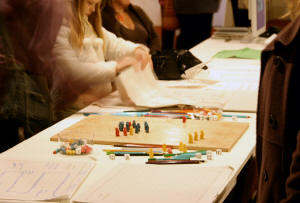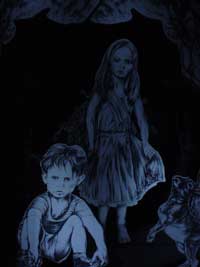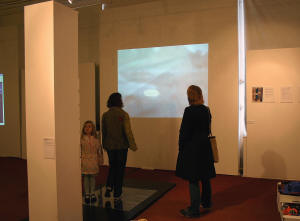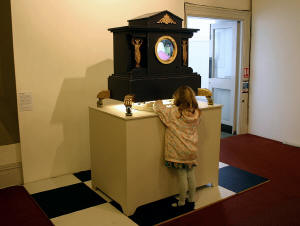|
|
|
| home | features | exhibitions | interviews | profiles | webprojects | gazetteer | links | archive | forum | |
|
|
|
|
Participation: an
exhibition and debate
I-res, The Poly, Falmouth, 26th -30th October Megan Wakefield
'Falmouth’s last
works had involved manipulating people’s despair, pensiveness, ennui.
Those were malleable materials, lightly guarded by their possessors.
The Aparty was another matter. Here,
Jonathan Letham You Don’t Love Me
Yet (in which one
character is called, spookily,
“We invite you to explore
your personal decision to participate” states Magda Tyzlik-Carver in her
introduction to the Participation catalogue, thereby shifting the focus
away from the artworks themselves to the behaviour of the visitors. I
had this decision in mind during the Saturday afternoon debate held in
the midst of the 10-person show. The exhibition and related workshops
involved artists with various connections to both UCF and the IRES
Research “cluster” (Research in Interactive Art & Design) and, according
to the curator, each of the pieces represented a different approach to
participation.“Why use participation in your work?” Tyzlik-Carver asked
the assembled artists, “What did you expect from it?”
 Sara
Matthews (left)
wanted her work to be “playful”, something that a “non-art” audience
could comfortably engage in. She
had created a board game depicting segmented land masses with brightly
coloured pieces you could use to “journey” across the continents.
Suggestions about strategies involving the die and chance took the place
of rules, and gridded paper was provided so that people could design and
play out their personal journeys or those of others. Sara
Matthews (left)
wanted her work to be “playful”, something that a “non-art” audience
could comfortably engage in. She
had created a board game depicting segmented land masses with brightly
coloured pieces you could use to “journey” across the continents.
Suggestions about strategies involving the die and chance took the place
of rules, and gridded paper was provided so that people could design and
play out their personal journeys or those of others.
Ana Carvalho spoke about
the process of learning through interaction, both learning about others
and learning in the sense of sharing skills to achieve an outcome.
Carvalho had two works in the show, one a collaborative piece in
partnership with Tim Shear and Pedro Lima. Journeys Through Space
and Time (below right)
was an audio-visual installation requiring the
audience to activate film clips (depicting journeys Ana had made from
Illustrator Susan Corke
(below left)
described how a viewer’s encounter with her piece could be
participatory. Peepshow was influenced by pre-cinematic devices
with a fixed viewpoint such as toy theatres and dioramas; a wardrobe was
painted black, the door held ajar. You could peer in from the front, or
through a hole in the back and have a partial view of suspended layers
of drawn cutouts; petrified paper butterflies, frocks and figures.
Corke described the artist’s role as only a
starting point in
the process of participation,
and she raised the question of authorship as a collective event. She
constructs spaces that cannot be penetrated physically, dramatizing our
inability to return to the realm of dreams or the space of childhood,
and she spoke about an element of
 “voyeurism
and complicity” in the act of looking into these spaces, which is itself
she believes a participatory act. “voyeurism
and complicity” in the act of looking into these spaces, which is itself
she believes a participatory act.
Magda addressed the
question as to whether one could distinguish between participation and
“interactivity”. Perhaps interaction, she suggested, meant that the
“audience” could discover the rules for themselves. They would become
active components in the development of ideas.
Jem Mackay
(below right) responded to
her questions about power relations within the rules of participatory
engagement by talking about the participant’s control within a
collaborative process. His work (and comments) emphasized the importance
of collaboration between participants in exchanges that did not
necessarily take place within the gallery walls. Mackay had created a
sort of directed web forum where participants could collaborate to make
a film based on the legend of King Arthur
(see webprojects: Jem Mackay). Individuals
could upload scripts, concepts, images, film clips and technical
know-how, prompted by a daily email task from the artist. There was
space for the editing of content by participants and a potted history by
So is everyone a
participant? Are those who read Jem Mackay's web log or peer into Susan
Corke's wardrobe participating on a critical level and is this equally
as valid as physical participation/interaction with the work? Can one
can be a co-creator, while remaining a spectator? If you discount the
decision of whether or not to participate at all, it seems that none of
the works prompted participation in the Brechtian sense, in that they
did not require the spectator to take a political position by presenting
an oppositional situation. Rather there seemed to be a pervasive desire,
certainly in Mackay’s work to “activate” the subject through
participation.
Guy Debord describes such
activation as an essential precursor to the determination of one’s
reality, but also - and here is the emphasis of the show – as an aid to
the production of new social relations. In the case of Mackay’s work the
mechanisms for potential collaboration are put in place and hence the
devolution of authority on the part of the artist. MacKay described the
process of collaboration as the enhancement of the artist’s unique
vision and it was this process that really interested him.
I found the interplay of
the collective and the individual fascinating in Brookes work. Her
project Bind (above left and below)
used the idea of making a quilt from objects
belonging to individuals (in this case objects due to be discarded)
evoking memories of a person, place or experience. The idea had arisen
from her response to a story about a widow cutting up the clothes of her
recently dead husband, to sew them into a quilt. Her original intention
had been to invite individuals to her workshop with their objects, and
there to construct one large singular object. She described how people
arrived with strong and diverse conceptions of how they would bind their
objects and she made the decision to relinquish control of the process
to some extent and to allow the participants to author their own
separate pieces. Her display consisted of documentation (the typed
lists of objects and names of individuals), black and white portraits,
the bound pieces themselves alongside boxes stuffed full with
objects, potential material for viewer participation.
Brookes had been explicit
about her own interest in the binding process (she displayed a statement
about her thoughts on intimacy and the bonds inherent in many female
relationships), while this co-authored work simultaneously revealed
irrepressible individual signatures, a true patchwork quilt.
This interplay was reflected in some of the
concluding comments in the debate, centering on control; participation
as a game of power relations arising from the authorless work (described
variously by Barthes and Umberto Eco), where the artist is no longer
responsible for reception.
The difficulty of assessing
the quality of participatory relations was raised at least once, as was
the decision of the subject to refuse to participate. For me this show
reflected for the most part a drive towards relational co-creation, in
the spirit of Bourriaud’s Relational Aesthetics, which considers
the “productive existence” of the viewer. In fact the debate itself had
more of a subversive potential than the work. None of the artists seemed
to have the intention of creating work where the deliberate use of power
play between co-authors may have induced discomfort in their audience.
Most of the work was aimed at prompting spontaneous action or arresting
attention towards something previously unseen, or inducing reverie; in
any case the drive was towards a “positive” experience.
Robin Hawes had simply displayed the end point in his collaborative experiments; photographs which illustrated the saccades (or eye movements) made by one’s eye as it contemplates an object. Looking at his beautiful framed prints, each one a huge blurred iris, I regretted that I wouldn’t be able to participate in his workshop.
Conversely, Journeys through Space and Time, the experiment in collaborative Visual Jockeying did not engage me. It was fine that I could trigger image or sound by moving over sensors in the floor, but I wanted the image to be more vibrant, less bleached and random, so that I could feel satisfaction in my act of co-creation.
I
was one of the only participants in the Saturday debate to not be
directly involved in the production of the work, but here I am adding to
the “post-production”, expanding the discourse. Is my participation (and
that of the artists in the debate) ultimately a self-reflexive activity,
eschewing any social agenda to activate the viewer, or indeed the
artist? Should we worry? Hasn’t art, as Magda suggested at one point,
always been a marginal or elitist activity? If art were truly democratic
would we still dignify it with the label art or would we call it craft
or therapy or creative collaboration?
As
far as general audience participation went, I cannot comment, not having
fully participated in all the
The debate was great because it unfurled before and with its participants and the work seemed closely thought through and varied. It was also a relief to see something like this at The Poly, hardly a radical venue, but having just seen 'No Programme' at the Plymouth Arts Centre and the 'Offload' festival in Bristol, I was and am intrigued by the possibilities of relational/participatory/engaged/whatever art to expand beyond the gallery space.
bottom two pictures: Jane Bailey 'Vanishing points: person, place and mediation' & Jason Cleverly 'Sacred and Mundane' for more info go to www.ires.org.uk/participation
|
|


